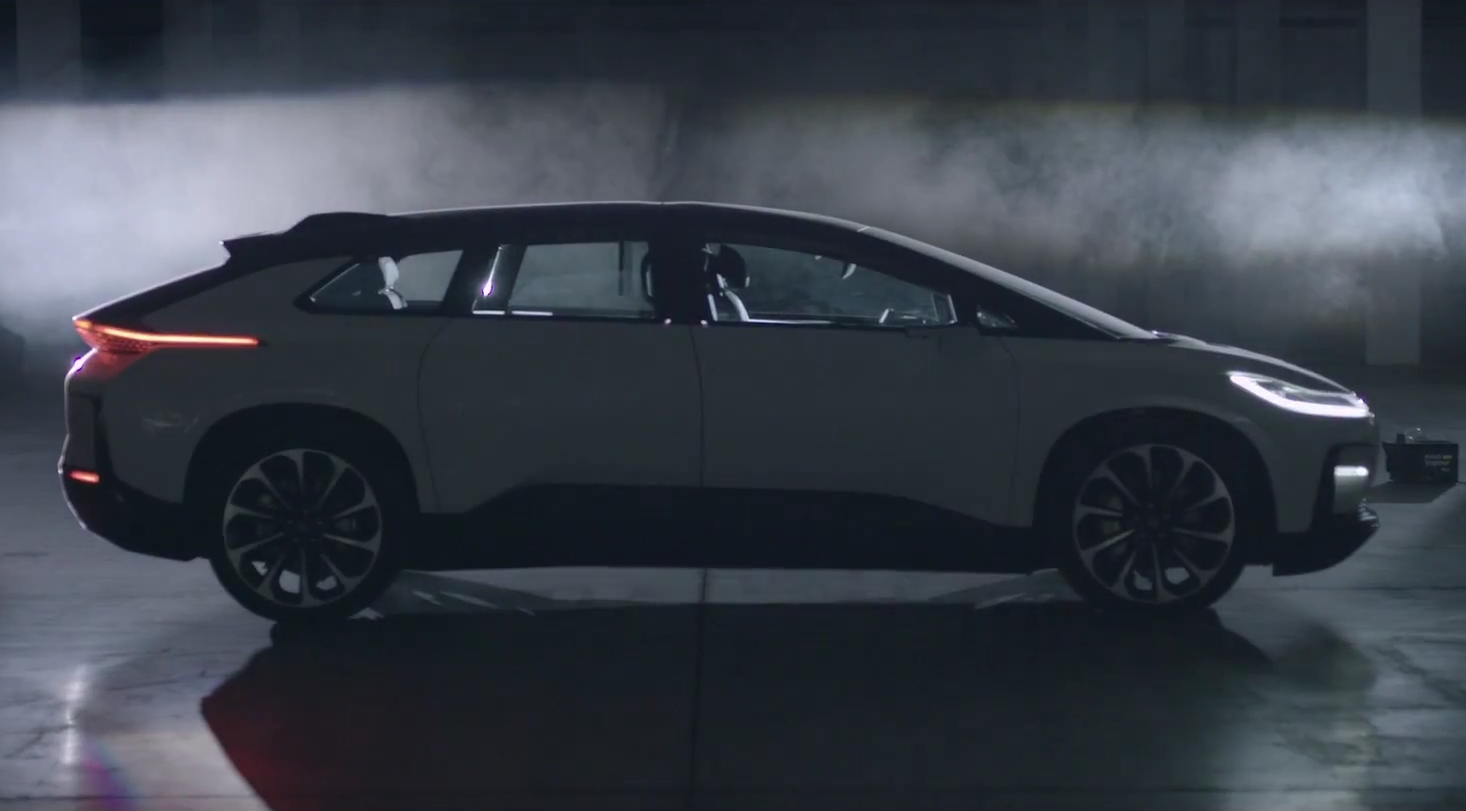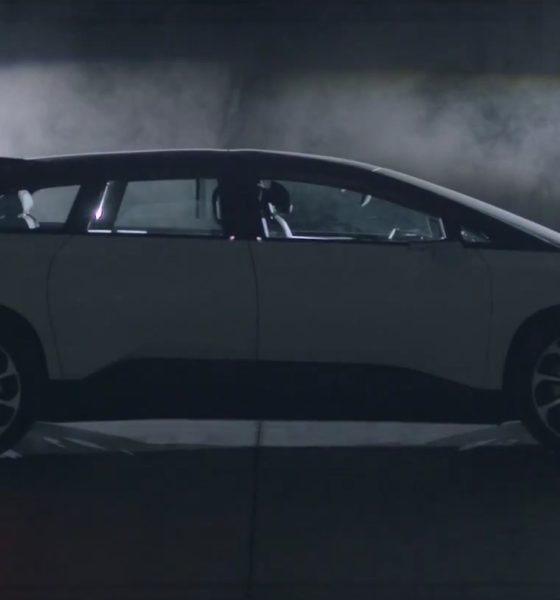

News
Faraday Future pushes another FF 91 teaser amid financial backer troubles
Amidst news of troubles with a major financial backer, Faraday Future has published another teaser video for its first vehicle, the FF 91 all-electric SUV. Seemingly addressing its current challenges, the electric car startup pledged that it would always be moving forward, one step at a time, as the company pushes to bring its first vehicle to the market.
With ongoing issues with a key investor, Faraday Future is reportedly fighting to stay afloat once more. According to recent reports, Faraday Future is implementing pay cuts across the company, with some employees receiving a 20% reduction to their hourly wages. Several members of Faraday Future’s management team have committed to take pay cuts that are larger than 20% as well, and CEO Jia Yueting has reportedly pledged to decrease his salary to just $1.
The pay cuts come as Faraday Future’s CEO battles with the company’s main investor, Evergrande Health, a subsidiary of property developer China Evergrande Group. Evergrande swooped in late last year with a $2 billion pledge to save the electric car startup and help bring the FF 91 luxury SUV to market.
An email from Faraday Future’s management, which was retrieved by The Verge, notes that the pay cuts are temporary, and that salaries will be restored once funding is secured. That said, the company had already begun laying off some of its employees to help keep Faraday Future afloat nonetheless.
“The company is committed to monitoring its finances and will reevaluate this decision with the goal of restoring salaries once funding is available,” the email reportedly read.
When Evergrande stepped in to save the company last year with its $2 billion commitment, the investor got a 45% stake in the company. Evergrande gave the first installment of $800 million at the beginning of 2018, but by the middle of the year, the entirety of the funds had already been spent. The Faraday Future CEO later attempted to get the board of directors to approve an advance of $700 million more, and when Evergrande refused, Jia took the case to HK Arbitration Center. In a blog post earlier this month, Faraday Future claimed that Evergrande failed to make any payments beyond the original $800 million.
“Contrary to what Evergrande has told the press and its shareholders, neither FF’s CEO YT Jia nor anyone else “manipulated” the board of Evergrande in reaching these agreements. In agreeing to bring a portion of its payments forward to 2018, Evergrande had a full understanding of why the funds were needed, and when they were needed, in order to achieve production and delivery of FF 91 in 2019.
“But contrary to what has been reported, Evergrande failed to make any of the promised additional payments beyond the original $800m investment, despite FF and its CEO complying with their obligations and meeting all required conditions for funding under the July 2018 agreement. Instead, Evergrande held the payments back to try to gain control and ownership over FF China and all of FF’s IP. At the same time, Evergrande is preventing FF from accepting any immediate financing from other sources.”
Faraday Future has made some progress over the years. This past August, the electric car startup was able to build a pre-production version of the FF 91, its first luxury SUV. The FF 91 is a luxury SUV with a 0-60 mph time of 2.4 seconds, a 130 kWh battery pack, and an estimated range of 289 miles per charge. The vehicle also includes LiDAR for self-driving capabilities and four-wheel steering for impressive maneuverability.
Watch Faraday Future’s latest FF 91 teaser in the video below.

News
Tesla FSD fleet is nearing 7 billion total miles, including 2.5 billion city miles
As can be seen on Tesla’s official FSD webpage, vehicles equipped with the system have now navigated over 6.99 billion miles.

Tesla’s Full Self-Driving (Supervised) fleet is closing in on almost 7 billion total miles driven, as per data posted by the company on its official FSD webpage.
These figures hint at the massive scale of data fueling Tesla’s rapid FSD improvements, which have been quite notable as of late.
FSD mileage milestones
As can be seen on Tesla’s official FSD webpage, vehicles equipped with the system have now navigated over 6.99 billion miles. Tesla owner and avid FSD tester Whole Mars Catalog also shared a screenshot indicating that from the nearly 7 billion miles traveled by the FSD fleet, more than 2.5 billion miles were driven inside cities.
City miles are particularly valuable for complex urban scenarios like unprotected turns, pedestrian interactions, and traffic lights. This is also the difference-maker for FSD, as only complex solutions, such as Waymo’s self-driving taxis, operate similarly on inner-city streets. And even then, incidents such as the San Francisco blackouts have proven challenging for sensor-rich vehicles like Waymos.
Tesla’s data edge
Tesla has a number of advantages in the autonomous vehicle sector, one of which is the size of its fleet and the number of vehicles training FSD on real-world roads. Tesla’s nearly 7 billion FSD miles then allow the company to roll out updates that make its vehicles behave like they are being driven by experienced drivers, even if they are operating on their own.
So notable are Tesla’s improvements to FSD that NVIDIA Director of Robotics Jim Fan, after experiencing FSD v14, noted that the system is the first AI that passes what he described as a “Physical Turing Test.”
“Despite knowing exactly how robot learning works, I still find it magical watching the steering wheel turn by itself. First it feels surreal, next it becomes routine. Then, like the smartphone, taking it away actively hurts. This is how humanity gets rewired and glued to god-like technologies,” Fan wrote in a post on X.
News
Tesla starts showing how FSD will change lives in Europe
Local officials tested the system on narrow country roads and were impressed by FSD’s smooth, human-like driving, with some calling the service a game-changer for everyday life in areas that are far from urban centers.

Tesla has launched Europe’s first public shuttle service using Full Self-Driving (Supervised) in the rural Eifelkreis Bitburg-Prüm region of Germany, demonstrating how the technology can restore independence and mobility for people who struggle with limited transport options.
Local officials tested the system on narrow country roads and were impressed by FSD’s smooth, human-like driving, with some calling the service a game-changer for everyday life in areas that are far from urban centers.
Officials see real impact on rural residents
Arzfeld Mayor Johannes Kuhl and District Administrator Andreas Kruppert personally tested the Tesla shuttle service. This allowed them to see just how well FSD navigated winding lanes and rural roads confidently. Kruppert said, “Autonomous driving sounds like science fiction to many, but we simply see here that it works totally well in rural regions too.” Kuhl, for his part, also noted that FSD “feels like a very experienced driver.”
The pilot complements the area’s “Citizen Bus” program, which provides on-demand rides for elderly residents who can no longer drive themselves. Tesla Europe shared a video of a demonstration of the service, highlighting how FSD gives people their freedom back, even in places where public transport is not as prevalent.
What the Ministry for Economic Affairs and Transport says
Rhineland-Palatinate’s Minister Daniela Schmitt supported the project, praising the collaboration that made this “first of its kind in Europe” possible. As per the ministry, the rural rollout for the service shows FSD’s potential beyond major cities, and it delivers tangible benefits like grocery runs, doctor visits, and social connections for isolated residents.
“Reliable and flexible mobility is especially vital in rural areas. With the launch of a shuttle service using self-driving vehicles (FSD supervised) by Tesla in the Eifelkreis Bitburg-Prüm, an innovative pilot project is now getting underway that complements local community bus services. It is the first project of its kind in Europe.
“The result is a real gain for rural mobility: greater accessibility, more flexibility and tangible benefits for everyday life. A strong signal for innovation, cooperation and future-oriented mobility beyond urban centers,” the ministry wrote in a LinkedIn post.
News
Tesla China quietly posts Robotaxi-related job listing
Tesla China is currently seeking a Low Voltage Electrical Engineer to work on circuit board design for the company’s autonomous vehicles.

Tesla has posted a new job listing in Shanghai explicitly tied to its Robotaxi program, fueling speculation that the company is preparing to launch its dedicated autonomous ride-hailing service in China.
As noted in the listing, Tesla China is currently seeking a Low Voltage Electrical Engineer to work on circuit board design for the company’s autonomous vehicles.
Robotaxi-specific role
The listing, which was shared on social media platform X by industry watcher @tslaming, suggested that Tesla China is looking to fill the role urgently. The job listing itself specifically mentions that the person hired for the role will be working on the Low Voltage Hardware team, which would design the circuit boards that would serve as the nervous system of the Robotaxi.
Key tasks for the role, as indicated in the job listing, include collaboration with PCB layout, firmware, mechanical, program management, and validation teams, among other responsibilities. The role is based in Shanghai.
China Robotaxi launch
China represents a massive potential market for robotaxis, with its dense urban centers and supportive policies in select cities. Tesla has limited permission to roll out FSD in the country, though despite this, its vehicles have been hailed as among the best in the market when it comes to autonomous features. So far, at least, it appears that China supports Tesla’s FSD and Robotaxi rollout.
This was hinted at in November, when Tesla brought the Cybercab to the 8th China International Import Expo (CIIE) in Shanghai, marking the first time that the autonomous two-seater was brought to the Asia-Pacific region. The vehicle, despite not having a release date in China, received a significant amount of interest among the event’s attendees.








